![]()
![]()
![]()
Use LEFT and RIGHT arrow keys to navigate between flashcards;
Use UP and DOWN arrow keys to flip the card;
H to show hint;
A reads text to speech;
89 Cards in this Set
- Front
- Back
|
Prokaryotic |
*Polycistronic- more then one gene is transcribed at a time. *No modification of mRNA *30, 50s units 70s of ribosomes |
|
|
Eukaryotic |
*Monocistronic- only one gene transcribed at a time *mRNA must be modified introns removed *40, 60s units 80s of ribosomes |
|
|
RNA |
* Single stranded * Ribose sugar * A,C,G,U * A-U * C-G * Brings message code to ribosome for protien |
|
|
DNA |
* Double stranded * Deoxyribose * A, C, G, T * A-T * C-G * Genetic code * Self replicating |
|
|
Genome |
Complete set of genetic information |
|
|
Cells must accomplish two tasks |
1. DNA replication- copies genetic material (S phase) 2. Gene expression (transcription and translation during G1 and G2) |
|
|
Information flows from DNA>RNA>Protien |
. |
|
|
Denaturing or melting |
Separating DNA strands |
|
|
What bonds hold together single strands? |
Covalent bonds |
|
|
What type of bonds hold together double strands? |
Hydrogen bonds |
|
|
Protien-encoding gene> transcription > messenger RNA> translation > protien |
. |
|
|
Cells control the level of what? |
Protien synthesis |
|
|
Semi conservative |
Saving 1/2 the original strand |
|
|
Origin of replication |
Where DNA begins |
|
|
What can occur from a chemical mutigen |
Alkalating agent
|
|
|
What would we call something that is trip minus |
Oxitrop |
|
|
What kind of medium would we use for trip minus |
Complex medium-nutrient rich |
|
|
DNA replication |
Requires a primes |
|
|
Primase |
Enzyme that makes an RNA primer 5 to 3 prime |
|
|
DNA replication usually is bidirectional |
Creates two replication forks, ultimately meet at terminating site when process is complete |
|
|
Where does replication begin? |
Origin of replication |
|
|
Replication process |
* Protiens recognize and bind to site * Melt double stranded DNA * Primer attatches |
|
|
DNA synthesizes in 5' to 3' direction |
DNA polymerase can only add nucleotides, not initiate |
|
|
Transcription |
RNA synthesizes single stranded RNA Uses DNA template Synthesizes in 5' to 3' direction Can initiate without primer Binds to promoter Stops at terminator |
|
|
tRNA- always has anticodon |
. |
|
|
DNA>transcription>mRNA (transcript)> translation>polypeptide formation>moves to ribosomes |
. |
|
|
Replisomes |
"Assembly line" |
|
|
1 codon= 1 amino acid |
. |
|
|
RNA sequence is complimentary, antiparallel to DNA template strand |
DNA template is (-) strand Compliment is (+) strand RNA has same sequence as (+) DNA except uraci instead of thymine |
|
|
mRNA transcripts may contain one or many genes |
. |
|
|
mRNA transcripts may contain one or many genes |
. |
|
|
Promoter |
Denotes begining of genes |
|
|
RNA polymerase plus a sigma factor determine what? |
Which genes will be transcribed |
|
|
Promoter does what? |
Orients direction of transcription |
|
|
Where is the promotor located? |
Found upstream of genes |
|
|
Process of decoding information in mRNA |
*mRNA is temporary copy of genetic information *Major components are mRNA, ribosomes, tRNAs, and accessory protiens |
|
|
Genetic code: 3 nucleotides = codon |
. |
|
|
Nucleotide sequence defines coding region |
Designates beginning, end of region to be translated |
|
|
. |
. |
|
|
. |
. |
|
|
Semiconservative |
In the two new molecules generated each one has one new strand and one original strand |
|
|
What is origin of replication? |
The site at which replication originates |
|
|
Why are primers required in DNA replication but not in transcription? |
DNA polymerase can only add nucleotides to an existing fragment; RNA polymerase can start synthesis without a primer. |
|
|
What is polycistronic mRNA? |
It carries the information for more than one gene. |
|
|
What is the function of a sigma factor? |
It is the portion of RNA polymerase that recognizes the promoter |
|
|
What is the date of a protien that has a signal sequence? |
The signal sequence directs secretion |
|
|
What is the date of a protien that has a signal sequence? |
The signal sequence directs secretion |
|
|
All of the following are involved in transcription except A) polymerase B) primer C) promoter D)sigma factor E)uracil |
Primer |
|
|
All of the following are directly involved in DNA replication except A)promoter B)ribosome C)start codon D)stop codon E)tRNA |
Promoter |
|
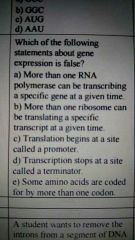
|
C) translation begins at a site called a promoter |
|
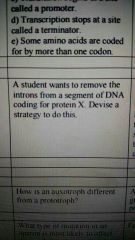
|
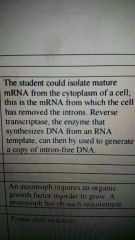
|
|
|
How is an auxotroph different from a prototroph? |
An auxotroph requires an organic growth factor in order to grow. A prototroph has no such requirement. |
|
|
What type of mutation in an operon most likely to affect the synthesis of more than one protien? |
Frame shift mutation |
|
|
What is meant by "proofreading" with respect to DNA polymerase? |
The removal of an incorrect base and the incorporation of the correct base in its place |
|
|
Why is replica plating used to isolate an auxotrophic mutant from a prototrophic parent? |
Because there is no medium on which the auxotroph will grow and the prototroph will not. Therefore direct selection is not possible |
|
|
What is transduction? |
The transfer of bacterial DNA enclosed in a bacteriophage head from one bacterium to another |
|
|
How is an F+ strain different from an Hfr strain? |
The F+ cell has transferable plasmid whereas the Hfr cell has the plasmid intergrated into the chromosome of the cell |
|
|
Name three mobile genetic elements |
Plasmids, bacteriophage, transporons |
|
|
Why are R plasmids important? |
Because they carry genes conferring resistance to various antibiotics and can be readily transferred to other bacteria |
|
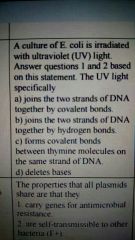
|
Forms covalent bonds between Thymine molecules on the same strand of DNA. |
|
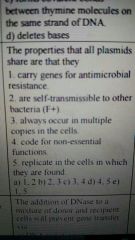
|
D) 4,5 |
|
|
The addition of DNase to a mixture of donor and recipient cells will prevent gene transfer via A)DNA transformation B) chromosome transfer by conjugation C) plasmid transfer by conjugation D) generalized transduction |
A) DNA transformation |
|
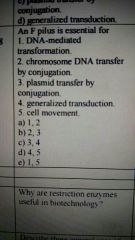
|
B) 2,3 |
|
|
Why are restriction enzymes useful in biotechnology? |
They cut DNA in a predictable and controllable manner. In addition, some generate "sticky ends" making it easy to join other fragments of DNA to them. |
|
|
Describe 3 general uses of genetically engineered bacteria |
1) Produce medically important protiens 2) DNA library production 3) vaccine production |
|
|
Describe the function of a reporter gene |
It is used to detect expression of a given gene. |
|
|
What is a DNA library? |
A collection of clones that together contain the entire genome of an organism |
|
|
What is cDNA? Why is it used when cloning eukaryotic genes? |
DNA synthesized from an mRNA template (copy DNA.) It does not contain introns. |
|
|
Describe the function of a probe |
It binds to specific sequences of DNA, allowing those sequences to be detected. |
|
|
What is the function of a vector? |
Carries cloned DNA, allowing it to replicate in cells |
|
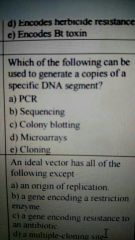
|
A) PCR |
|
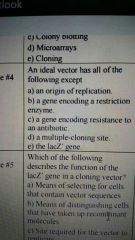
|
B) a gene encoding a restriction enzyme |
|
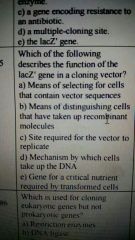
|
B) means of distinguishing cells that have taken up recombinant molecules |
|
|
Which is used for cloning eukaryotic genes but not prokaryotic genes? A) Restriction enzymes B) DNA ligase C) reverse transcriptase D) vector E) Selectable marker |
C) reverse transcriptase |
|
|
The polymerase chain reaction uses Taq polymerase rather than a DNA polymerase from E. Coli because Taq polymerase is? |
Heat stable |
|
|
If an organism lost the ability to make primase, what would it be unable to do? |
Add a short sequence of complementary RNA to the existing DNA strand. |
|
|
If an organism lost the ability to make primase, what would it be unable to do? |
Add a short sequence of complementary RNA to the existing DNA strand. |
|
|
If an organism lost the ability to make primase, what would it be unable to do? |
Add a short sequence of complementary RNA to the existing DNA strand. |
|
|
DNA requires a template for what? |
Synthesis of DNA |
|
|
What enzyme, in the early process of DNA replication, separates the two strands? |
Helicase |
|
|
Okazaki fragments |
On one of the strands of bacterial DNA the new complimentary strand is synthesized discontinuously into small pieces of DNA |
|
|
RNA is a chain of? |
Nucleotides |
|
|
What component of RNA is different from one individual or bacterium to the next? |
Order of nitrogenous bases |
|
|
Transcription begins when RNA polymerase binds to the |
Promoter in DNA |
|
|
A segment of DNA encoding a protien or an RNA molecule is a? |
Gene |
|
|
Bonds connecting amino acids? |
Peptide |
|
|
Protien synthesis occurs in the? |
Ribosomes |
|
|
Replication, transcription, and translation take place where?. |
In the bacterial cytoplasm |
|
|
... |
. |

